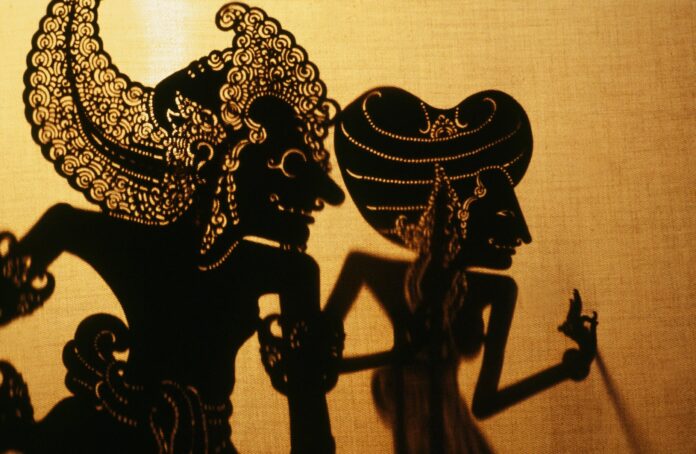An ancient Indonesian tradition, faithfully recreated
By JACOB ANDERSON — arts@theaggie.org
On Nov. 19, ShadowLight Productions performed a Wayang Bali, or Balinese Shadow Play, just north of the Mondavi Center. The play, scored by four instruments known as gender wayang (a ten-keyed tool reminiscent of the xylophone and suspended over a bamboo resonator), took place on a tan cloth screen, behind which the obscure warping shape of fire could be glimpsed, fed occasionally by a hard-built man wearing a mask. The screen is meant to represent the world, while the flickering lamp takes the role of the sun. The assistants, garbed in flowing Balinese ceremonial wear, peeked from either side of the screen as rawhide puppets moved between thin racks, and the fire was quietly fretted over.
The dalang is God, and on Nov. 19, that God was Larry Reed, the founder of ShadowLight Productions, whom The California Aggie had the pleasure of speaking to after the show. In between the intricate, looping motifs of the musicians, the dalang served as showrunner, puppeteer and lone speaker. After signaling his performers with a small gavel held between his right toes, his puppets fluttered into view. At first, they were barely visible, maintaining a distance from the taut screen so the shadows remained huge, ambiguous objects, before shrinking and revealing their true form as they approached.
“The stories all come from the ‘Mahabharata,’ the Indian myth. The four main stories are the trunk, and there are invented stories that keep getting added to it: twigs, leaves,” said Reed. “The whole thing is improvised. The stories look very different from night to night.”
The puppets are distinctly animated, with limbs and jaws miming the shrugs and subtle jokes that accompany the narrative. Some of these puppets, such as the king of the ogres, Niwatakawaca, have bodies comprising lattices which seem to spiral inward, like a fractal. They summon the self-derivative essence of the stories themselves.
“You could’ve taken any sentence from this story and used it to make a new story. That would’ve been a leaf,” said Reed.
The most important characters speak in a language known as Kawi, which the show’s program describes as “an archaic literary language based on Old Javanese and Old Balinese that is close to Sanskrit.” These voices Reed delivers in a slow growl, fitting for the imposing stature of the Kings and demons that occupy the play’s world. The “fool” characters then explain the larger action of the story in English with a comedic tilt.
“In Bali, every ceremony is incomplete without a masked theater piece or a shadow play,” said Reed. “They’re usually two or three hours,” (this performance sitting at a comfortable 80 minutes) “and in Java they used to be from dusk to dawn.”
This one is titled “The Meditation of Arjuna” and concerns the immortal Niwatakawaca and the disciplined meditator Arjuna, who poses the only threat to his scheme of marrying the most beautiful nymph of heaven. Reed weaves cultural explanations and mordant wit into the proceedings, eliciting not a few waves of laughter from the crowd. Afterward, the fire is extinguished and Reed, 77 years old, sits on the edge of the metal stage, wrapped in a thick jacket and sporting a newsboy cap in stark contrast to the golden headpiece in which he performed. He asks The Aggie to hand him his shoes, which sit below, barely outside his reach.
“I’ve been doing this since 1972,” he said. “I went to Indonesia, and I saw this form, I liked it, and when I came back, I found a school of Wayang Bali. Then I returned to Indonesia. There were a lot of cultural differences, a lot of languages to be learned.”
When asked about the puppets, he said, “I’ve made a few myself, but this is an old set. It’s about a hundred years old. They’re handed down through families, usually, and one family will make the puppets.”
Reed said this story was the first he ever learned, so he has performed it many times.
“Now I’m revisiting it to try to learn some new things about it,” Reed said. “It was fun. At one point I had, I’d say maybe fifteen stories in my rotation. Now that I’m not performing as much, it’s shrunk.”
The audience in a shadow play is not expected to stay in one place during the performance. As the story unravels, heads struggling to see above the crowd break off to stand at the sides and catch glimpses of the practiced workings behind the screen. The instrumentalists lean over the keys in a tight square, half of them doubling the notes of the others in a higher register, resulting in a naturally staggered sound.
“We’re not going anywhere else right now. Not until somebody invites us.” After saying that, Reed chuckled. ShadowLight Productions has been around since 1972, with a mission of “expanding the scope of Shadow Theatre as an artistic expression and as a tool for cross-cultural understanding,” funded in part by the Hewlett Foundation and Grants for the Arts, among others. As assistants gather props and implements, Reed continues sitting and talking with those who have stuck around after the show.
Correction: A previous version of this article incorrectly stated that another organization funded ShadowLight Productions, as well as listed the wrong materials with which the puppets are made. The article has been corrected to reflect the correct fundors and show details.
Written by: Jacob Anderson — arts@theaggie.org




